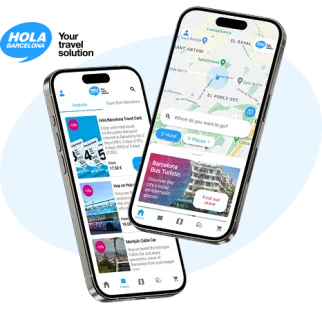Gaudí
The Modernista genius
As one of the greatest exponents of Modernista architecture, Gaudí was responsible for many of the city’s most emblematic buildings. Overflowing with imagination fuelled by nature’s organic forms, Gaudí managed to develop a unique style that combined rich ornamentation with architectural mastery.

Barcelona Bus Turístic, on the Hola Barcelona app
Your app for visiting the city with the Barcelona Bus Turístic: routes, stops and the most iconic places. A comfortable way to carry your tickets too!
Antoni Gaudí in Barcelona
Antoni Gaudí was an architect who was recognised as one of the greatest geniuses of his craft. Even though he is considered to be one of the maximum exponents of Modernisme, his initial projects were influenced by other currents. This is the case of Casa Vicens, in which straight lines predominate over curves; and Torre Bellesguard and the Col·legi de les Teresianes, in which the Catalan neo-Gothic style lends them the appearance of a castle; and even Palau Güell, an example of the architect’s orientalist period, dominated by ornamentation in the Arabic, Byzantine and Mudejar styles. This palace, built from 1886 to 1890, was one of Gaudí’s first collaborations with the man who would be his main patron, Eusebi Güell, for whom during the same period he also built the Pavellons Güell, which are guarded by an impressive iron dragon with glass eyes.
Although in these works Gaudí had not yet entered his full Modernista period, his primary source of inspiration is clearly visible: nature, to whose forms, colours and geometry he was magnetically drawn. Gaudí’s true Modernista explosion, in which organic forms, the famous "trencadís" broken tile mosaic style and his obsession with the removal of buttresses reached their zenith, took place at the start of the 20th century, when he designed the Park Güell, a true ode to nature, and when on Passeig de Gràcia he fully transformed Casa Batlló into a fairy-tale building, with its characteristic wavy balconies and railings in the form of a mask, and built La Pedrera with columns and floors completely free of load-bearing walls and a facade that simulates the waves of the sea tossing wrought-iron seaweed.
Gaudí’s most emblematic work, however, was incomplete when he died and is still not finished. The Sagrada Família, the symbol of Barcelona to which Gaudí dedicated the last 15 years of his life, is continuing to grow in an effort to reach the heavens.
Gaudí Route with Barcelona Bus Turístic
With Barcelona Bus Turístic you can visit all Gaudí’s works in Barcelona.
To get to Casa Batlló and La Pedrera you can take the Blue Route or the Red Route and hop off at the stops on Passeig de Gràcia named after these buildings.
If you hop on the Blue Route of Barcelona Bus Turístic, you can see virtually all of Gaudí’s works. After Passeig de Gràcia, the route goes to the Sagrada Família and then to the Gràcia district, which is home to Casa Vicens. The route continues up to Park Güell and then it stops on Avinguda del Tibidabo, where Torre Bellesguard is. The Sarrià district is home to the Col·legi de les Teresianes and at the Palau Reial – Pavellons Güell stop you can see the famous dragon with glass eyes guarding the door. Finally, if you hop off at the Diagonal – Les Corts stop, you can walk to the Finca Miralles Gate.
To visit Palau Güell, the first major construction undertaken by Gaudí, you can hop on the Red Route of Barcelona Bus Turístic and hop off at the Colom – Museu Marítim stop.





















